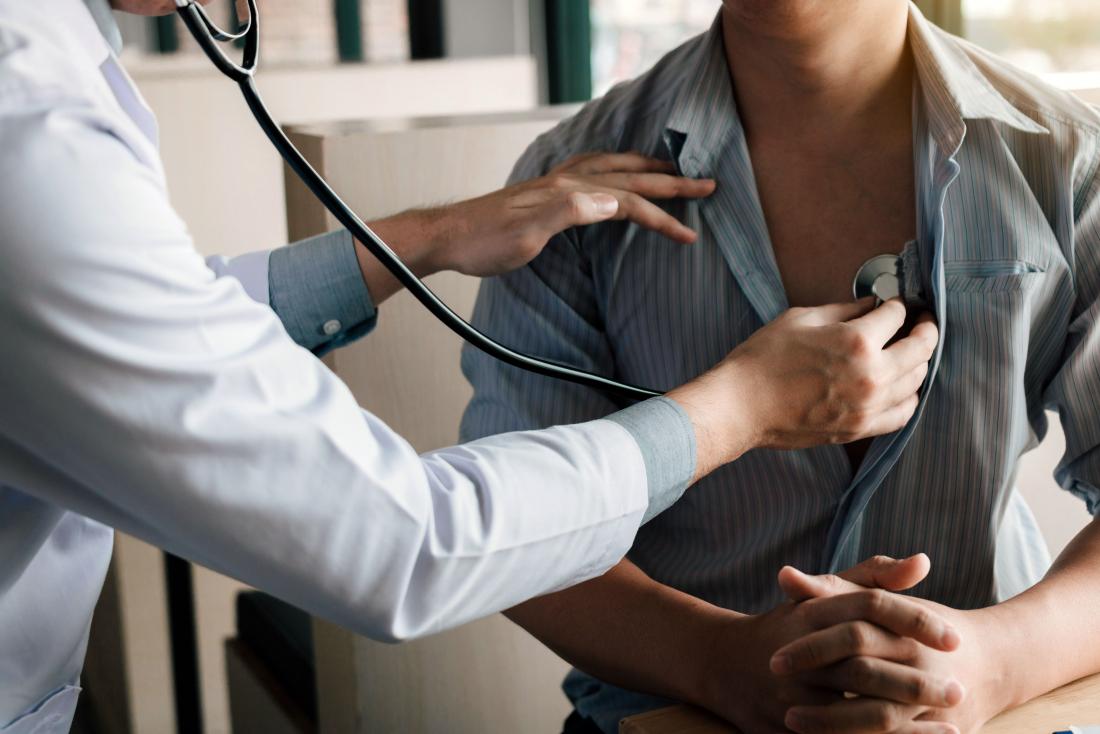A doctor or nurse may recommend a physical to:
- check for possible diseases or medical conditions
- check for medical issues that may become a problem later on
- keep track of any changes in a person’s physical health
- determine whether a person needs further tests
In this article, we discuss what to expect during a routine physical exam. We also cover some specific types of physical exam.
What to expect

A healthcare professional may listen to the chest during a physical exam.
Healthcare professionals typically carry out a physical exam in their office or in a dedicated room in a medical clinic or hospital.
It is important for the doctor or nurse to make sure that a person feels comfortable during a physical exam. The American Medical Association require clinics to provide a chaperone on request and to allow people to bring a friend or relative into the examination room with them.
Usually, the healthcare professional will also take a medical history before moving onto the physical exam. A medical history is a record of the person’s current symptoms as well as any risk factors and previous medical issues that might be relevant.
The doctor or nurse may ask about:
- past and current diseases or medical conditions
- previous operations or medical procedures
- past immunizations
- any medicines, vitamins, minerals, and herbal remedies that the person is currently taking
- current signs and symptoms
- lifestyle information, such as diet and exercise habits, the use of tobacco and alcohol, and sexual and reproductive history
- family history of health conditions or diseases
Exactly what the physical examination entails will depend on the reason for the test, but in general it can include:
- height and weight measurements
- nose, mouth, throat, and ear examination with a torch or scope
- feeling for the pulse in the person’s neck, groin, or feet
- checking the body’s reflexes
- listening to the heart and lungs with a stethoscope
- measuring blood pressure using a sphygmomanometer
- feeling the lymph nodes in the neck, underarms, or groin
- feeling the abdomen to check for abnormalities
For babies and young children, a physical exam may include:
- asking questions about their development and growth
- measuring the circumference of their head
- checking their fine motor development, such as by asking them to pick up small items or tie their shoelaces
- checking their gross motor development, which can include asking them to walk, climb stairs, or jump
- looking in the mouth, eyes, and ears
- listening to the chest
- checking the health of the genitals
- tapping on the knees to check reflexes
- examining the feet
Sometimes, people undergo physical examinations to check for a particular issue or health condition. In these cases, the healthcare professional may carry out specific tests in addition to or instead of those above. We discuss some of these specific tests below.
Skin exam
Doctors recommend regular skin exams to look for suspicious growths, moles, or other changes that may be a sign of skin cancer. These exams are particularly important for people with risk factors for skin cancer, such as those with a family history of the condition.
A doctor may include a skin exam as part of a routine checkup. The exam will typically involve the doctor checking the person’s skin from head to toe.
Clinical breast exam
A healthcare professional may recommend a clinical breast exam to check for abnormalities in and around the breast area.
During this exam, they will use the pads of their fingers to check the entire breast, including the underarm and collarbone area.
If they spot a lump, they will note its size, shape, and texture and check whether it moves easily. This is because lumps that are soft, smooth, round, and movable tend to be noncancerous cysts.
The doctor will usually then recommend further diagnostic tests.
Pap test and pelvic exam

A Pap test is one physical exam a female might undergo.
During a pelvic exam, a healthcare professional will examine the female reproductive organs to check for any gynecological problems. They may also perform a Pap test to check for signs of cervical cancer.
Doctors usually recommend that females have their first pelvic exam when they turn 21 years old or if they experience any of the following symptoms:
- unexplained pain in the lower stomach or around the vulva
- vaginal discharge that itches, burns, or smells unpleasant
- bleeding from the vagina that lasts longer than 10 days
- missed periods
- severe menstrual cramps
During the appointment, the doctor will usually ask the person about their periods and sexual activity. They will then ask the person to take off their underwear and lie on the table with their feet in stirrups and a sheet covering their stomach and legs.
The healthcare professional will visually inspect the area outside of the vagina before moving on to the speculum exam. A speculum is a small plastic or metal instrument. They will insert it into the vagina and then gently open it so that they can see the vaginal canal and cervix.
For the Pap test part of the examination, the doctor will use a plastic stick to collect a sample of cells from the inside of the cervix. They will then send this sample to a laboratory for analysis.
Learn more about Pap tests here.
Digital rectal exam
Healthcare professionals commonly use a digital rectum exam to check for signs of prostate cancer in males. They may recommend the exam for people at higher risk of prostate cancer or those who experience any of the following symptoms:
- bleeding from the rectum
- a change in bowel habits
- blood in the semen or urine
- pain when ejaculating
- urination difficulties
A digital rectal exam only takes a few minutes. It is not usually painful, but it may be uncomfortable.
The doctor will ask the person to take off their pants and underwear before giving them a gown or cloth to wrap around themselves. The person will then either stand and bend forward at the waist or lie on their side in the fetal position on an exam table.
The healthcare professional will then gently insert a gloved and lubricated finger into the rectum to inspect the prostate for its size and the presence of any bumps, soft or hard spots, and other abnormalities. They will also examine the wall of the lower colon, or rectum.
Learn more about these types of test here.
Summary
Physical exams are a routine part of healthcare. Doctors and nurses use them to check on a person’s general health, look for potential medical issues, and monitor specific signs.
If a doctor suspects an underlying health condition, they will usually recommend further diagnostic testing.
They will usually do everything they can to help people feel as comfortable as possible during physical exams. Anyone who has any concerns about undergoing a physical exam should speak to their doctor.
